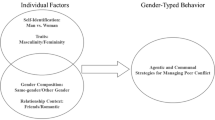Abstract
Previous research has clearly established important gender differences in how intimacy is viewed within a narrow set of relationships, primarily those with same-sex peers. This article presents a new social pressures model that delineates a set of diverse forces believed to influence gender differences in intimacy across a much wider set of social relationships during early adolescence. Although it was impossible to examine the actual operation of the postulated pressures, an extensive data set on all the important people in the lives of over 2000 seventh- through tenth-grade white suburban adolescents made it possible to test a set of 22 hypotheses derived from the model. These hypotheses covered relationships with nuclear, extended family, and nonkin members of the social network who were of different ages and genders. Results indicated that, while gender differences in the perceived intimacy of relationships were widespread, they were neither present in all types of relationships nor were those found always in the same direction. Furthermore, the social pressures model developed accurately predicted both the location and direction of the gender differences across most of the 22 different types of relationships. Suggestions for an elaboration of the model are noted, along with additional research issues that need to be addressed.
Similar content being viewed by others
Reference
Bem, S. L. Androgeny and gender schema theory: A conceptual and empirical integration. In T. B. Sonderegger (Ed.), Nebraska Symposium on Motivation: Psychology and gender (Vol. 32). Lincoln, NE: University of Nebraska Press, 1985.
Berndt, T. The features and effects of friendship in early adolescence. Child Development, 1982, 53, 1447–1460.
Bigelow, B. Children's friendship expectations: A cognitive developmental study. Child Development, 1977, 48, 246–253.
Bigelow, B, & LaGaipa, J. Children's written descriptions of friendship. Developmental Psychology, 1975, 11, 857–858.
Blyth, D. A. Mapping the social world of adolescents: Issues, techniques, and problems. In F. C. Serafica (Ed.), Social-cognitive development in context. New York: Guilford Press, 1982.
Blyth, D. A., Hill, J. P., & Thiel, K. S. Early adolescents' significant others: Grade and gender differences in perceived relationships with familial and nonfamilial adults and young people. Journal of Youth and Adolescence, 1982, 11, 425–450.
Caldwell, M. A., & Peplau, L. A. Sex differences in same-sex friendships. Sex Roles, 1982, 8, 721–732.
Cleveland, D. Incest: The story of three women. Lexington, MA: Lexington Books, 1986.
Cochran, M. M., & Brassard, J. A. Child development and personal social networks. Child Development, 1979, 50, 601–616.
Cozby, P. C. Self-disclosure: a literature review. Psychological Bulletin, 1973, 79, 73–91.
Crockett, L., Losoff, M., & Petersen, A. C. Perceptions of the peer group and friendship in early adolescence. Journal of Early Adolescence, 1984, 4, 155–181.
Diaz, R., & Berndt, T. Children's knowledge of a best friend: Fact or fancy? Developmental Psychology, 1982, 18, 787–794.
Douvan, E., & Adelson, J. The adolescent experience. New York: Wiley, 1966.
Dunphy, D. The social structure of urban adolescent peer groups. Sociometry, 1963, 26, 230–246.
Eagly, A. H., & Crowley, M. Gender and helping behavior: A meta-analytic review of the social psychological literature. Psychological Bulletin, 1986, 100, 283–308.
Fischer, J. L. Transitions in relationships style from adolescence to young adulthood. Journal of Youth and Adolescence, 1981, 10, 11–23.
Gilligan, C. In a different voice: Psychological theory and women's development. Cambridge, MA: Harvard University Press, 1982.
Hartup, W. Peer relations. In P. H. Mussen (Ed.), Handbook of child psychology: Socialization, personality, and social development (Vol. IV, 4th ed.). New York: Wiley, 1983.
Herek, G. M. Beyond “homophobia”: A social psychological perspective on attitudes toward lesbian and gay men. Journal of Homosexuality, 1984, 10, 1–21.
Hill, J. P., & Lynch, M. E. The intensification of gender-related role expectations during early adolescence. In J. Brooks-Gunn & A. P. Peterson (Eds.), Girls at puberty: Biological and psychosocial perspectives. New York: Plenum, 1983.
Hinde, R. A. Why do the sexes behave differently in close relationships? Journal of Social and Personal Relationships, 1984, 1, 471–501.
Hoffman, M. L. Sex differences in empathy and related behaviors. Psychological Bulletin, 1977, 84, 712–722.
Kessler, R. C., McLead, J. D., & Wethington, E. The costs of caring: A perspective on the relationship between sex and psychological distress. In I. H. Saranson & B. R. Saranson (Eds.), Social support: Theory research, and applications. Dordrecht: Martinus Nijhoff, 1985.
Kite, M. E. Sex differences in attitudes towards homosexuals: A meta-analytic review. Journal of Homosexuality, 1984, 10, 69–81.
Lever, J. Sex differences in the games children play. Social Problems, 1984, 23, 478–487.
Mark, E. W., & Apler, T. G. Sex differences in intimacy motivation. Psychology of Women Quarterly, 1984, 5, 164–169.
Reis, H. T., Senchak, M., & Solomon, B. Sex differences in intimacy of social interaction: Further examination of potential explanations. Journal of Personality and Social Psychology, 1985, 48, 1204–1217.
Savin-Williams, R. C. Adolescence: An ethological perspective. New York: Springer-Verlag, 1986.
Sharabany, R., Gershoni, R., & Hoffman, J. E. Girlfriend, boyfriend: Age and sex differences in intimate friendship. Developmental Psychology, 1981, 17, 800–808.
Steinberg, L. Transformations in family relationships at puberty. Developmental Psychology, 1981, 17, 833–840.
Steinberg, L. Adolescence. New York: Alfred A. Knopf, 1985.
Wright, P. H. Men's friendships, women's friendships and the alleged inferiority of the latter. Sex Roles, 1982, 8, 1–20.
Author information
Authors and Affiliations
Additional information
This work was supported by a grant from the William T. Grant Foundation of New York and the former Boys Town Center for the Study of Youth Development in Omaha, Nebraska. A special word of thanks goes to Deborah Durant and Barbara Olmsted for their assistance in earlier work on this issue and to John Hill for his role as Coinvestigator in the original project.
Rights and permissions
About this article
Cite this article
Blyth, D.A., Foster-Clark, F.S. Gender differences in perceived intimacy with different members of adolescents' social networks. Sex Roles 17, 689–718 (1987). https://doi.org/10.1007/BF00287683
Issue Date:
DOI: https://doi.org/10.1007/BF00287683




